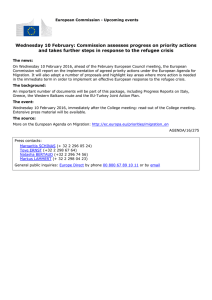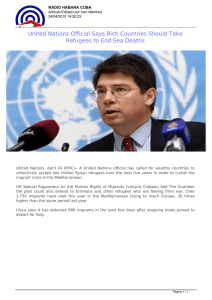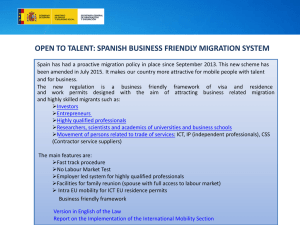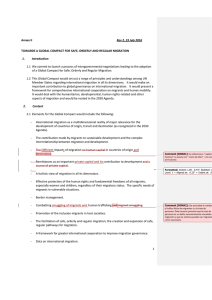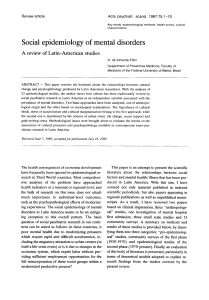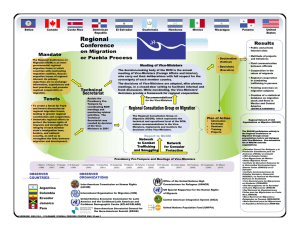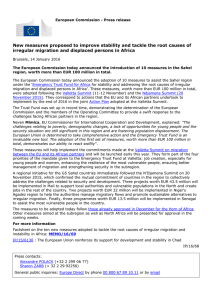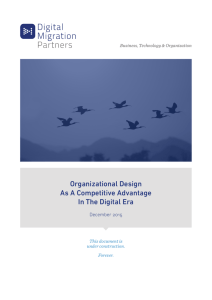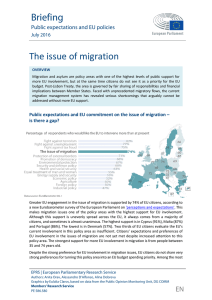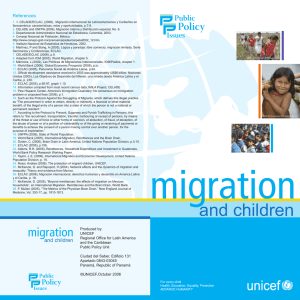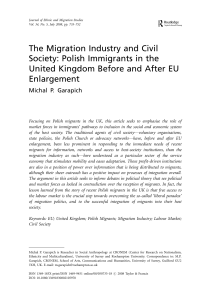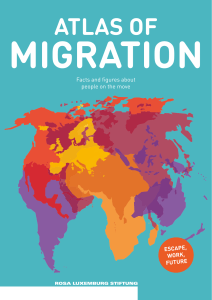IS WHAT WE HEAR ABOUT MIGRATION REALLY TRUE
Anuncio
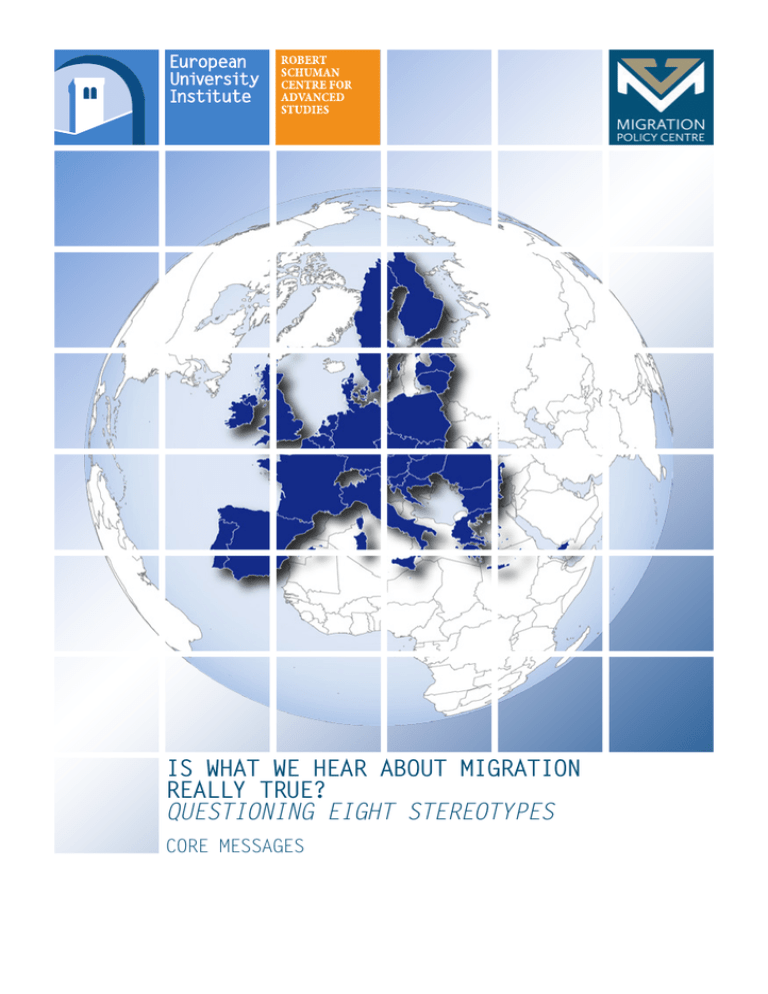
IS WHAT WE HEAR ABOUT MIGRATION REALLY TRUE? QUESTIONING EIGHT STEREOTYPES CORE MESSAGES FOREWORD For decades, the topic of immigration has been polarising European political arenas. The view that immigration can be a positive contribution to Europe has had its defendants and its opponents, and it has often been the matter of harsh debates. In recent years, however, the dispute between the two groups often seems to have largely vanished. If not all politicians share the same principles about migration and migrants, fewer and fewer dare to defend the view that migration is, and will continue to be, needed. They follow the trends of public opinion, in which increasingly large fractions see migrants as competitors in labour markets beset by unemployment, burdens on endangered welfare systems, and a factor of social disruption. This is in large part a result of the current crisis, which has exacerbated economic and social tensions and given rise to the search for scapegoats. If the opinion that migration is a threat rather than an asset prevails, there is a risk that European States will forego the positive benefits of immigration and make decisions that undermine Europe’s recovery from the crisis and, ultimately, its leading position in the world. This booklet re-thinks eight migration stereotypes in the light of research findings established by the Migration Policy Centre. It is based on the detailed volume: “Is what we hear about migration really true? Questioning eight stereotypes.” – Philippe Fargues, Director of the Migration Policy Centre Authored by Cameron Thibos. Based on the report Is what we hear about migration really true? Questioning eight stereotypes, edited by Philippe Fargues. Contributors to the full report Sara Bonfanti, Migration Policy Centre (MPC), Robert Schuman Centre for Advanced Studies (RSCAS), European University Institute (EUI) Anna Di Bartolomeo, MPC, RSCAS, EUI Philippe Fargues, MPC, RSCAS, EUI Pawel Kaczmarczyk, Warsaw University and formerly MPC, RSCAS, EUI Sona Kalantaryan, MPC, RSCAS , EUI Kathryn Lum, MPC, RSCAS, EUI Iván Martín, MPC, RSCAS, EUI, and CIDOB, Barcelona Center for International Affairs Hillel Rapoport, MPC, RSCAS, EUI and Paris School of Economics Cameron Thibos, MPC, RSCAS, EUI Alessandra Venturini, MPC, RSCAS, EUI and University of Turin Download the full report at: www.migrationpolicycentre.eu/migration-stereotypes STEREOTYPE 1 “WE DO NOT NEED MIGRANTS” It is a common belief that migration harms European societies, and that the European Union would be better off with either very few immigrants or none at all. Such perceptions are misguided, and they risk causing serious damage to the EU’s economy, living standards, and global clout if they are used as a basis for policy. The EU is shrinking. The EU27 held 14.5% of the world’s population after World War II. Today, with a total population of 500 million, the EU’s relative weight has been cut in half (7%). EUROSTAT predicts that without further migration, the combined population of the EU27 in 2050 will be 58 million less than it was in 2010. If the EU continues to lose people, one unavoidable consequence will be the loss of its prominence in international affairs and global institutions. The EU is also getting older. An increase in the old-age dependency ratio from 28% in 2010 to 44% in 2030 means that the ratio of elderly people withdrawing from pension and welfare systems to those paying into them will increase from a bit more than 4 one quarter to almost one half (please note that the old-age dependency ratio is the number of older persons [age 65+] per 100 working-age persons [aged 20-64 years]). This will make such systems unsustainable. The EU workforce is also ageing rapidly (see figure). The number of young people (below 45) in the workforce, those with cutting-edge knowledge, will drop by a quarter over the next 11 years without further migration. On the other hand, the quantity of old workers (age 45+) will remain more or less constant. Such an ageing of the skills will negatively affect the EU’s global competitiveness. Natural increase and the incorporation of currently acceding states, even when combined, will not be enough to reverse these trends. However, immigration offers one method of mitigating their effects. The continued acceptance of young, working-age migrants will: bolster the EU’s workforce; help its social insurance systems remain solvent; and contribute to the global competitiveness of its economy. Is what we hear about migration really true? Projection of the employed population aged below 45 by Member State, 2010-2025, in the no migration scenario 110 Baseline 100 in 2010 100 90 80 70 2010 2015 2020 2025 AT BE BG CY CZ DE DK EE FR EL HU IE IT LV LT LU MT NL PL PT RO SK SI ES SE UK EU Source: Calculation based on Eurostat population projections with no migration (in Fargues and McCormick 2013) KEY TRENDS* •The population of the EU has increased continuously from 180 million in 1952 to 500 million in 2010. Of this increase, 70% (248 million) came from enlargement, while 30% (72 million) came from natural increase and migration. •The share of the world population living in the EU27 has steadily decreased, from 14.5% (380 million) in 1952 to 7% (500 million). With no more migration, over the next twenty years: •The EU27 will lose 33 million (-11%) working-age persons. •The EU’s old-age dependency ratio, people aged 65+ to the number of working-age people (20-65), will increase from 28% to 44%. •The portion of young workers (20-30) in the EU labour force will decrease by 25% while those aged 60-70 will increase by 29%. *Projections based on MPC’s demographic models 5 Questioning eight stereotypes STEREOTYPE 2 “MIGRANTS STEAL OUR JOBS” One of the most pervasive stereotypes in migration discourses today is that immigrants cause unemployment rates to rise by undercutting wages and occupying scarce jobs. The 2009 European Social Survey found that the share of the population who viewed migrants as competitors for jobs varied greatly depending on the Member State, with an EU27 average of just under 50%. We found that negative attitudes toward migrants were strongly correlated with the unemployment. In other words, the higher the unemployment rate the higher the share of respondents who thought immigrants take jobs away from native workers, and thus it seems the negative perception is rooted more in socio-economic hardship than in immigration. Indeed, migrants often avoid countries of high unemployment. We found that immigration and unemployment rates were negatively correlated in the majority of EU MS surveyed (15 of 23) after the crisis hit in 2008. In other words, states with high employment had high levels of immigration, 6 and vice versa. Ten of these countries also followed the dominant trend before the crisis began. For five MS, migration and unemployment levels began to move in the same direction – the two measures became positively correlated – once the crisis hit. Only three MS (Latvia, Cyprus and Luxembourg) show either positive or negative correlations in both periods, and in doing so provide some evidence to back up the stereotype. Why is high migration more often than not correlated with low unemployment? In part, it is because migrants gravitate to places where unemployment is low as they are more likely to find work there. It is also in part due to the fact that governments often restrict migrant entry during periods of high unemployment, which causes the two measures to move in opposite directions. Whatever the combination of factors, the dominant, negative correlation shows that using migration as a scapegoat for unemployment is largely unfounded. Is what we hear about migration really true? EU (27 Member States) quarterly unemployment by annual net migration, 2001-2012 2.5 2.0 1.5 1.0 0.5 0.0 -0.5 -1.0 -1.5 -2.0 -2.5 Q1 Q2 Q3 Q4 Q1 Q2 Q3 Q4 Q1 Q2 Q3 Q4 Q1 Q2 Q3 Q4 Q1 Q2 Q3 Q4 Q1 Q2 Q3 Q4 Q1 Q2 Q3 Q4 Q1 Q2 Q3 Q4 Q1 Q2 Q3 Q4 Q1 Q2 Q3 Q4 Q1 Q2 Q3 Q4 Q1 2001 2002 2003 2004 EU Unemployment 2005 2006 EU Net Migration Actual Source: Eurostat, McCormick (2012) 7 2007 Questioning eight stereotypes 2008 2009 2010 2011 EU Net Migration Projected 2012 STEREOTYPE 3 “WE DO NOT NEED LOW-SKILLED IMMIGRANTS IN THE EU” It is often thought that the path out of the current crisis is through the revitalisation and improvement of Europe’s knowledge economies. As such, it is commonly assumed that Europe no longer needs the type of labour that low-skilled migrants provide. Following this logic, MS migration policy usually attempts to attract highly-skilled migrants while containing and discouraging low-skilled migration. This is misguided. Low-skilled labourers are still necessary for national economies to function, but as a result of such migration policies the demand now often exceeds the supply. Low-skilled migrant labour also allows for the social mobility of natives. When migrants take over less desirable, but necessary work, they open up the space needed for natives to pursue higher-paying, higher-skilled employment opportunities. They also fill jobs left vacant by native workers, who perceive such employment as undesirable for reasons of low pay or low social status, among others. This is often true for national industries that require large, steady workforces and 8 are harmed by high turnover. The Italian dairy industry, which grossed €15 billion in 2011, is a good example of this. Wages are fairly high, contracts are long term, and the industry is a point of national pride, but for reasons of social status and personal aspiration native Italians refuse to milk cows. Migrant labour now keeps the industry running, and today it is estimated that nine out of every 10 dairy workers are from India. This is just one of many sectors in EU economies today that continues to need low-skilled, third-country labour in order to stay afloat. It is also important to note that EU member states are not the same and thus it is incorrect to generalise what the EU ‘needs’. They also attract different profiles of migrants, even from within a single country of origin, and employ them for different tasks. Italy draws on India almost completely for low-skilled workers, such as cow milking. In contrast, the United Kingdom engages predominantly semi-skilled and highly-skilled Indians for work across the entire employment spectrum (see figure). Is what we hear about migration really true? Indian migrant stocks by occupation in the UK and Italy UK 2011 Italy 2008 Managers, Directors and Senior Officials Professional Occupations Associate Professional and Technical Occupations Admin. and Secretarial Occupations Skilled Trades Occupations Crafts, semi-‐skilled and agriculture Process, Plant and Machine Operatives Elementary Occupations 0.0 10.0 20.0 30.0 Born in India 40.0 0.0 10.0 20.0 Indian citizens Sources: UK, Annual Population Survey 2011; Italy, Labour Force Suvey 2008 9 Questioning eight stereotypes 30.0 40.0 STEREOTYPE 4 “MIGRANTS UNDERMINE OUR WELFARE SYSTEMS” It is often thought that migrants take more than they give from their new countries of residence. This is particularly visible in discussions of welfare systems, where migrants are often labeled as benefit seekers or welfare tourists, among others. This perception most likely comes from the frequent use of highly conspicuous aspects of social insurance by some low-income migrants, such as unemployment benefits, subsidized housing, and child allowances. However, all of these services are relatively cheap for the state to provide, paling in comparison to the cost of government healthcare and pension systems. As migrants groups are structurally younger than native-born populations (see stereotype 1), as well as usually economically active, an above-average percentage of migrants pays into pension and healthcare schemes while a below-average share makes use of those benefits. For this reason, foreign-born populations are net positive contributors to the welfare systems of nearly every European country (see figure). For countries where this is not the case, the 10 fault lies more with the barriers to entry that migrants face when accessing labour markets than with immigration per se. Migrants are also thought to somehow threaten welfare systems and undermine group solidarity because some perceive them to be different from the majority population. The premise to this argument is that groups are more willing to redistribute wealth the more homogenous they are. However, there is little evidence that birthplace diversity negatively affects solidarity in Europe. In fact, the opposite is true. Immigration and the diversity arising from it translate into more positive attitudes toward redistribution. This is largely due to class interests that span the immigrant/ native divide. Highly-skilled natives perceive that similarly-skilled immigrants contribute to their economic interests and thus are willing to expand social safety nets to cover them. At the other end of the spectrum, low-skilled natives, like low-skilled migrants, make more frequent use of welfare systems. They are thus are more concerned with maintaining access to benefits than with the nationality of other beneficiaries. Is what we hear about migration really true? Differences in the net direct fiscal contribution of immigrant and native-born households and the role of different characteristics, 2007-2009 4000 Euros (PPP adjusted) 2000 0 -2000 -4000 -8000 Germany Sweden Belgium Denmark Poland Netherlands Finland Austria Iceland Slovakia Estonia Czech Republic France Slovenia OECD average Norway United States Australia United Kingdom Greece Portugal Italy Ireland Switzerland Hungary Spain Luxembourg -6000 Total difference Difference after adjustment for age Difference after adjustment for labour market status Difference after adjustment for education Source: Kaczmarczyk (2013) based on OECD (2013: 151) 11 Questioning eight stereotypes STEREOTYPE 5 “MIGRATION HAMPERS OUR CAPACITY TO INNOVATE” The stereotype that migration hampers innovation starts from the premise that migrants are low-skilled labour, and thus do not contribute to a nation’s innovative capacity. Since low-skilled migrants also accept low wages, it is further presumed that firms will not invest in R&D and laboursaving techniques if there is an abundant supply of migrant labour at their fingertips. This slows down the modernisation of industries and dulls Europe’s competitive edge. This logic is flawed for the simple reason that not all migrants are low-skilled. Research shows that both highly-skilled migrants and highly-diverse workplaces positively impact innovation. This is because immigrants both invent and contribute to the inventions of others. One way of seeing this is by looking at patent applications. We find that countries with relatively open immigration policies for specific, highly-skilled sectors receive more patent applications 12 than those with more restrictive policies. This research further finds that there are positive spillover effects from these sectors on the wages and innovative capacities of both complementary and non-related fields. In addition to this, studies show that overall diversity in the workplace, both in terms of the number of migrants and in terms of how many countries they represent, positively contributes to productivity. This is true at the regional, sector, and firm levels. Low-skilled migrants also have a role to play in the pursuit of innovation. By taking over some duties, such as child-care, they free highly-skilled workers to concentrate on other pursuits. This means that migration may actually help spur Europe out of the crisis rather than hinder its recovery. It will also contribute to Europe’s competitiveness at a time when challenges from South Korea, China and India are becoming more intense (see figure). Is what we hear about migration really true? Total patent applications for selected countries, 1883-2012 700 600 500 400 300 200 1883 1886 1889 1892 1895 1898 1901 1904 1907 1910 1913 1916 1919 1922 1925 1928 1931 1934 1937 1940 1943 1946 1949 1952 1955 1958 1961 1964 1967 1970 1973 1976 1979 1982 1985 1988 1991 1994 1997 2000 2003 2006 2009 2012 100 USA Japan India European Patent Office Source: WIPO Statistical Database, last updated January 2014 13 Questioning eight stereotypes China STEREOTYPE 6 “OUR SOUTHERN COASTLINE IS FLOODED WITH ASYLUM SEEKERS” Member States in the southeast of Europe often claim that they are overwhelmed by unprecedented numbers of asylum seekers crossing the Mediterranean and require increased burden sharing from more sheltered countries if they are to continue to accept refugees. Official statistics, however, draw a very different picture of the situation. There are indeed rising numbers of forced migrants around the world, but they are neither flooding Europe nor are they disproportionately found in supposedly ‘front-line’ states. The current number of refugees around the world is much lower than it was 20 years ago. Global refugee populations peaked with the fall of the Berlin Wall, dropped throughout the 1990s, and has held steady at around 10 million people since the turn of the millennium. The number of internally displaced people on the other hand, those who have escaped their homes but not their country, has skyrocketed from under 5 million in 1998 to 21 million today (see figure 1). European countries are obliged by the Geneva Convention to offer these at-risk people protection. However, as borders have become 14 increasingly difficult to cross they are more likely to end up as IDPs or in a country neighbouring their own. Today the vast majority of the world’s refugees and forced migrants are not in Europe but they are near it. This provides Europe with a false sense of security, for while relatively few refugees are on European territory the political stability of the neighbourhood in which it operates is increasingly at risk. Only a small portion of refugees that seek asylum in Europe do so in front-line countries, i.e. Greece, Italy and Malta. According to EUROSTAT, Germany, France and Sweden, all far from the troubles in the south-east, accounted for 57% of all asylum applications lodged in the EU last year. The picture changes slightly when we look as the number of asylum applicants per capita, which shows Sweden, Malta and Austria as being under the most pressure to accommodate (see figure 2,). Greece and Italy, on the other hand, are asked to give less than other states in both absolute and relative terms despite the number of headline-grabbing boat landings that happen on their shores. Is what we hear about migration really true? Fig.1 – Numbers of refugees and internally displaced persons 1998-2013 25,000,000 25,000,000 20,000,000 20,000,000 15,000,000 15,000,000 10,000,000 10,000,000 5,000,000 5,000,000 1998 1998 2000 2000 2002 2002 2004 2006 2008 2004 2006 2008 Refugees IDPs Refugees IDPs 2010 2010 2012 2012 2014 2014 Source: Authors’ graph, based on UNHCR data Fig.2 – Number of asylum applications per million inhabitants in 2013 7000 7000 Front-line member state Front-line member state 6000 6000 Back-line member state Back-line member state 5000 5000 4000 4000 3000 3000 Source: Authors’ graph, based on Eurostat data 15 Questioning eight stereotypes Austria Austria Czech Czech Republic Republic Poland Poland Croatia Croatia Ireland Ireland Slovenia Slovenia Spain Spain Latvia Latvia Lithuania Lithuania Romania Romania Estonia Estonia Slovakia Slovakia Portugal Portugal United United Kingdom Kingdom 1000 1000 Sweden Sweden Malta Malta Luxembourg Luxembourg Hungary Hungary Germany Germany Cyprus Cyprus Denmark Denmark Belgium Belgium Bulgaria Bulgaria France France Netherlands Netherlands Greece Greece Finland Finland Italy Italy 2000 2000 STEREOTYPE 7 “ECONOMIC MIGRANTS ARE TRYING TO CHEAT OUR ASYLUM SYSTEM” It is a common refrain that some migrants arriving to the EU by boat from across the Mediterranean want to cheat the asylum system in order to gain access to European labour markets. This flow of people is also assumed to be getting stronger. The reality is different. Between 1998 and 2009 the number of people crossing annually from Africa to Europe did not markedly increase. The most recent years have been more erratic, with uncommonly low numbers of arrivals in 2010 and 2012 offset by spikes in 2011 and 2013. The total for 2014 will also be high because of: the growing number of Syrians attempting to enter Europe by sea; the current political situation in Libya, which gives free reign to human smugglers; and Italy’s Mare Nostrum programme, which has rescued nearly 50,000 people since it began last October. The risk of dying during the voyage, however, has dramatically increased since the turn of the millennium, to the point that the Mediterranean crossing is now one of the most dangerous sea routes in the world (see figure 1). The probability of dying has been 16 consistently above 3%, meaning 30 people die for every 1000 that attempt to cross, for every year except 2010 according to MPC’s calculations. The rising death toll is largely due to the cat and mouse game being played on the high seas, in which migrants adapt to more intense surveillance by taking longer and more dangerous routes. Migrants arriving by sea are different from Europe’s other migrants and should not be assumed to be job seekers in disguise. They are overwhelmingly from Sub-Saharan Africa, particularly Eritrea, Nigeria and Somalia, as well as a handful of other trouble spots such as Syria and Afghanistan (see figure 2). With some exceptions these are not the main countries of origin for immigrants or asylum seekers in the EU. However, they are all countries with extreme political conditions, and most people fleeing them would qualify for international protection if they made it across the sea. This is true even if they pass through several other countries on their way to Europe, as the countries they transit are often as dangerous as their own. Is what we hear about migration really true? Fig.1 – Arrivals at sea in Italy, Spain, Malta and Greece 1998-2014 80,000 80,000 70,000 70,000 60,000 60,000 50,000 50,000 40,000 40,000 30,000 30,000 20,000 20,000 10,000 Italy Malta 20142014 20132013 20122012 20112011 Greece 20102010 20092009 Malta 20082008 20072007 Spain Spain 20062006 20052005 Italy 20042004 20032003 20022002 20012001 20002000 19991999 0 19981998 10,0000 Greece Notes: Greek data from 2009 onwards; Maltese data from 2008 onwards Sources: Italian Ministry of Interior; Spanish Ministry of Interior; Frontexwatch Malta; Hellenic Police, Ministry of Public Order & Citizen Protection Fig.2 – Probability of dying on irregular migration maritime routes to the EU, 1988-2013 (per 1,000) 50.0 50.0 40.0 40.0 30.0 30.0 20.0 20.0 10.0 10.0 0.0 1998 0.0 1998 2003 Italy + Malta Italy + Malta 2003 2013 2013 Spain Greece 2008 ALL ROUTES Spain Greece ALL ROUTES Source: Authors’ calculation based on Fortress Europe data 17 2008 Questioning eight stereotypes STEREOTYPE 8 “OUR CHILDREN SUFFER FROM HAVING IMMIGRANTS IN CLASS” It is commonly assumed that the quality of schools gets worse the more immigrants there are in the student body. Statistics are used to support this claim, which seem to show that children of immigrants underperform when compared to the children of natives regardless of the type of school, grade level, or MS of residence. This evidence is being misread. It is not the child’s origin that makes him or her less likely to succeed in school, but the level of resources at their disposal. We analysed 2009 PISA data on school performance and social background for nearly 120,000 students across the EU15. We wanted to know if children with a multicultural background – those with one native and one foreign-born parent – fared better than children with a monocultural background – those with two native or two foreign-born parents. We found that children of mixed couples perform significantly better than the children of immigrants. Furthermore, when compared with native children a multicultural background either boosted performance or had no effect. In short, having a multicultural background did not hurt. 18 There are some countries, such as Germany, where having a multicultural background appeared to negatively affect school performance at first glance, however this vanished when we controlled for socio-economic characteristics. In other words, the fact that a large percentage of migrants underperform in school is not because one of their parents was born in a different country, but because a large percentage of multicultural families belong to a socio-economic class that affords them only limited access to resources. We also wanted to know what the average effect of immigrant children is on school performance. We found that while high numbers of immigrants are indeed found in low-performing schools, suggesting at first blush that they are causing the schools to underperform, once again the correlation disappears once socio-economic characteristics are taken into account. Our study, which looked at nearly 5,000 schools across the EU15 found that school performance is unequivocally rooted in their socio-economic composition and not in their ethnic makeup. Is what we hear about migration really true? Average differential in reading performance by country of residence and origin before and after controlling for structural characteristics (*), 2009 (**) Children of mixed couples Children of natives Portugal United Kingdom Ireland Greece Netherlands Sweden Italy Austria Denmark France Finland Germany Spain Luxembourg Belgium -30.0 -20.0 -10.0 0.0 10.0 20.0 Notes: (*) The following structural characteristics were controlled for: sex, parents’ educational and occupational level, PISA Index of home cultural possessions and type of family; (**) No significant values are marked in blank Source: Authors’ elaboration on PISA-2009 19 Questioning eight stereotypes Published by the European University Institute, Robert Schuman Centre for Advanced Studies, Migration Policy Centre. © European University Institute, 2014 The Migration Policy Centre at the European University Institute, Florence, conducts advanced research on global migration to serve migration governance needs at European level, from developing, implementing and monitoring migration-related policies to assessing their impact on the wider economy and society. Links to an electronic version of this publication, which is available free of charge, may be found on the MPC website at www.migrationpolicycentre.eu For queries regarding this publication, please contact the MPC at [email protected] CONTACTS Migration Policy Centre Robert Schuman Centre for Advanced Studies European University Institute Via delle Fontanelle 18 I-50014 San Domenico di Fiesole (FI), Italy Tel: (+39) 055 4685 817 Fax: (+39) 055 4685 770 Email: [email protected] Website: www.migrationpolicycentre.eu Based on the report: Is what we hear about migration really true? Questioning eight stereotypes (ISBN 978-92-9084-213-2; DOI:10.2870/11242) The full report is available online at: www.migrationpolicycentre.eu/migration-stereotypes The Migration Policy Centre receives financing from the European Commission. This publication reflects the views only of the author(s), and the Commission cannot be held responsible for any use which may be made of the information contained therein.
